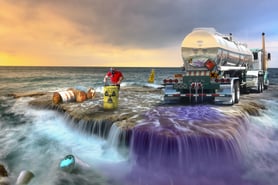
National waste management laws and regulations provide management requirements to the perceived hazards of each category, under overall regulation by the Environmental Protection Agency (EPA). Effective September 8, 2020, EPA will make extensive technical revisions to its standards for the “ignitability characteristic”, so entities that generate or manage wastes that might be ignitable should now review those wastes and associated management requirements.
How does EPA define which wastes are “hazardous wastes”?
The demarcation between “hazardous” and “nonhazardous” waste is crucial to national requirements. Beginning with the Solid Waste Disposal Act of 1965 (SWDA), all wastes are subject to basic disposal requirements. Beginning with the Resource Conservation and Recovery Act of 1976 (RCRA), ever-growing sets of wastes are defined as “hazardous” and subjected to requirements tailored by EPA based on each waste’s perceived hazards. RCRA sets out three basic ways to define a waste as hazardous:
-
The statutory and regulatory definitions of “solid waste” and “hazardous waste,” which include mandates for certain exclusions and exemptions.
-
Regulatory listing by EPA of specific hazardous wastes, coupled with methods for “delisting” specific wastes.
-
Hazardous characteristics of wastes, both physical hazards and adverse health effects.
EPA’ recent revisions address the third point, under which a waste is hazardous if it exhibits one or more “characteristics” that make it physically or biologically hazardous. EPA defines four classes of characteristic hazardous wastes (“D Wastes” in its regulatory typology):
-
corrosivity (D002)
-
ignitability (D001)
-
reactivity (D003)
-
toxicity (D004 – D043)
EPA specifies test methodologies for these determinations, as well as other testing and evaluation requirements under RCRA. Most appear in EPA’s Test Methods for Evaluating Solid Waste, Physical/Chemical Methods (EPA Publication SW 846), which practitioners refer to as “SW 846.”
How is EPA amending the ignitability characteristic?
EPA first defined the ignitability characteristic in 1980, and has revised its definition several times in the intervening 40 years (40 C.F.R. § 261.21). In general, a waste is ignitable if it can easily be lighted, or if ignited burns so vigorously that it creates a hazard. RCRA regulations presently include the following in this category:
-
liquids that are less than 24% alcohol, and have a flash point below 140°F (60°C), as measured by specified methods/standards
-
nonliquids that at standard temperature and pressure can cause fire by means of friction, absorption of moisture, or spontaneous chemical changes and that, when ignited, burn so vigorously and persistently that they create a hazard
-
ignitable compressed gases, as measured by specified methods/standards
-
oxidizers, as measured by specified methods/standards
Paint wastes, nonhalogenated degreasers, thinners and solvents (petroleum distillates), stripping agents, epoxy resins, adhesives, rubber cements and glues, and some waste inks are all examples of ignitable wastes.
EPA is making technical changes and updates in three of the four items enumerated above – item (2) is not changing. The changes are:
-
EPA is adding a general qualifier that the liquid be at least 50% water by weight, and is updating and changing the cross-references to ASTM (American Society of Testing and Materials) standards (adding ASTM D3278-78, D8174-18, and D8175-18), and adding two test methods from SW 846 (1010B and 1020C)
-
(unchanged)
-
EPA is updating cross-references to Department of Transportation (DOT) to what is now the Pipeline and Hazardous Materials Safety Administration (PHMSA)
-
EPA is updating cross-references to PHMSA
EPA is also removing four enumerated end-notes to section 261.21 that referenced DOT. EPA is also making conforming changes to cross-reference in several other rules.
What’s next?
Organizations now have until September 8 to review their generation of wastes that formerly met EPA’s definitions of ignitable hazardous wastes, and those that may meet the revised definitions.
Self-Assessment Checklist
Does the organization have operations that generate wastes that have qualified as hazardous wastes by applying EPA’s definition of the ignitability characteristic?
Has the organization reviewed its generated wastes to determine if any will qualify as hazardous wastes by applying EPA’s amended definition of the ignitability characteristic?
Where Can I Go For More Information?
About the Author
 Jon Elliott is President of Touchstone Environmental and has been a major contributor to STP’s product range for over 30 years.
Jon Elliott is President of Touchstone Environmental and has been a major contributor to STP’s product range for over 30 years.
Mr. Elliott has a diverse educational background. In addition to his Juris Doctor (University of California, Boalt Hall School of Law, 1981), he holds a Master of Public Policy (Goldman School of Public Policy [GSPP], UC Berkeley, 1980), and a Bachelor of Science in Mechanical Engineering (Princeton University, 1977).
Mr. Elliott is active in professional and community organizations. In addition, he is a past chairman of the Board of Directors of the GSPP Alumni Association, and past member of the Executive Committee of the State Bar of California's Environmental Law Section (including past chair of its Legislative Committee).
You may contact Mr. Elliott directly at: tei@ix.netcom.com

